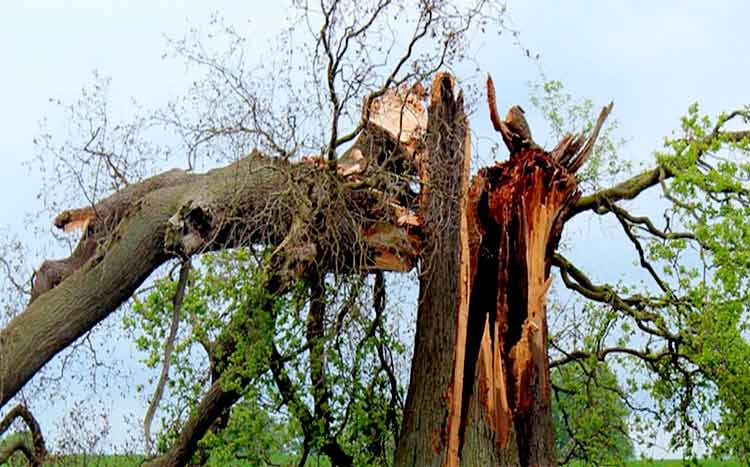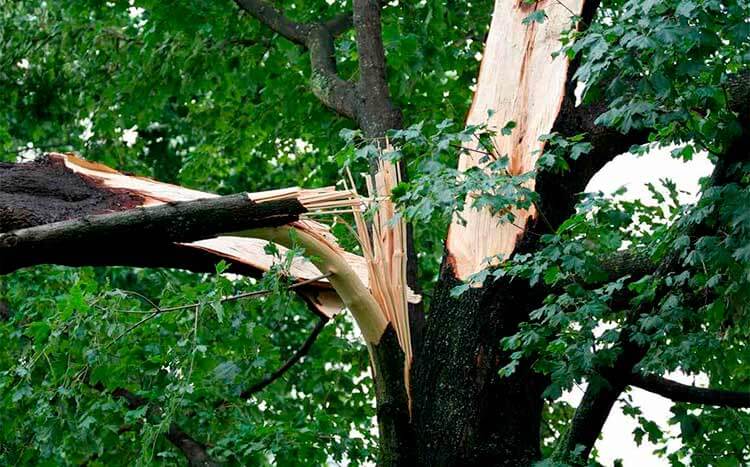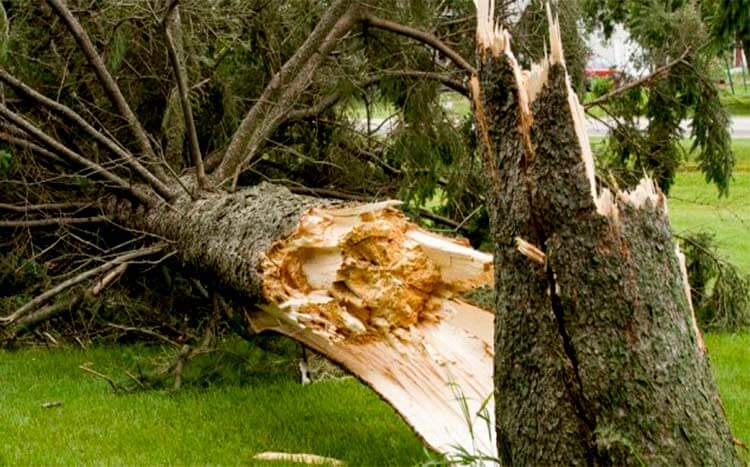Tree-related accidents are very common in the USA with some being fatal or leading to serious life-threatening injuries. According to a recent OSHA report1, over 100 tree-related deaths happen each year. It’s therefore important to know how to tell if a tree is dangerous and what you need to do.
Some of the telltale signs that a tree is not in good health and dangerous are a leaning, rotten, or compromised trunk, dry or decaying limbs, hanging branches, rotten or compromised roots, and an overburdened crown. Some of these problems can be fixed if discovered on time but safety should always be the priority.
What we cover
ToggleHow to Spot A Dangerous Tree (Use These Five Signs)
Look for these five signs as a starting point before you seek further from an arborist or tree surgeon:
Compromised Trunk
Never ignore problems affecting the trunk or stem because it is the most important part of a mature tree. The trunk supports the entire crown and has many functions that are important to the health and stability of the tree. If the trunk is compromised, then the tree could be in a bad condition and may fall or keel over especially in a storm.

Trunk problems that could make a tree dangerous include:
Leaning Trunk
A leaning trunk is usually a bad sign since it means the tree’s core root system has been compromised and could let go at any time. If you discover that your tree is leaning or spot a leaning tree, then you should do something to avoid the tree falling onto nearby structures or people.
Leaning trees are the most dangerous therefore requiring your immediate attention. Answers to the following questions can guide you on the steps to take when you discover a tree with a leaning trunk:
- How long has the trunk been leaning?
- In what direction is the tree leaning? Is it towards a structure or pathway?
- What could happen if the tree falls or keels over?
- How dense is the crown? Does the tree look healthy?
- Is the leaning angle increasing with time?
- Is the root system compromised?
It’s usually a good idea to have tree experts look at the tree and suggest ways to save it. It can be dangerous to cut or get near tall trees with leaning trunks as they can keel over at any time and cause damage or serious injuries.

Problems With The Bark
If the outer and inner bark on a trunk is rotten, peeling, soft to the touch, pest-infested, or discolored, then the trunk is probably weak and may break or split at any time. Problems with bark can be because of lightning strikes, bad weather, pests, diseases, physical stress, or lack of nutrients.
Some trees do recover or heal if the problem is not severe but additional checks should be done to ensure the trunk is sound. A tree expert can also brace or cable the tree so that it can recover.
Included bark, especially on multi-stemmed trees, is also a bad sign because it indicates that the internal bond between the stems is weak. Included bark usually presents wrinkled, ridged, or turned-in tissue at the
intersection of two stems or major limbs. Trees with bark inclusion are dangerous because they can split apart easily and without warning causing damage or injuring passersby.
Hollow Trunks
It’s not a bad thing to have hollows on the trunk of a large tree. Hollows play host to several small animals such as rodents and lizards and are not harmful to the tree. However, a tree trunk that has large hollows or cavities covering over fifty percent of a trunk’s diameter is a danger.
Large hollows or cavities on a trunk are a bad sign because the trunk can break under pressure especially if it has a large crown. Such trees should be cabled, braced, or removed in the worst-case scenario. The position and size of the hollow or cavity also determine how dangerous the tree is.
Large cracks or dead zones on the trunk
Trees can split or develop large cracks or dead zones due to physical impact when they sway violently in rough weather or when struck by lightning. It is important to have them checked for structural integrity, so they don’t fall onto houses or people without warning.
Note: Your responsibility as a good citizen is to report dangerous council trees so they can be removed or trimmed before they cause damage or injure pedestrians. Most cities have hotlines or online forms to report dangerous trees you’ve spotted in public areas such as parks and highways.
Dead or rotting Limbs
The second common sign of a dangerous tree is rotten or dead branches. Trees with dead branches should be removed (the branches not the tree) because they can fall onto houses, people, or motorists without warning.
Compromised branches also become dangerous projectiles in rough winds or during a storm. You can avoid this by having your trees trimmed or pruned regularly. Trimming gets rid of large branches to balance the crown or lessen its density, especially before hurricane season. Pruning gets rid of the deadwood, rotting, or disease-infested branches that can easily break off and cause damage or injure people.
Sometimes it may be difficult to identify dangerous branches on a large tree especially if it tends to shed its leaves and go into dormancy in fall and winter. A trained arborist can climb the tree and have a close look at the branches to see if they pose any danger. Sometimes, you don’t even need to cut off compromised branches if they can be saved through tree cabling or bracing.

Hanging Branches
This is a common problem with most trees, especially those with dense canopies. If you have a tree with compromised branches, you should have it checked and the branches trimmed or cabled. Such branches easily break off and can fall into houses, cars, or people. Branches hanging precariously or loosely attached to the stem need not be on the tree because they serve no purpose.
Rotten or Compromised Roots
Roots anchor the tree to the ground keeping it stable even in bad weather in addition to absorbing water and nutrients from the soil. When the roots start to rot or are compromised in any way, the whole tree is affected.
Rotten roots are a sign that the tree is dead or about to die which usually means that it could fall at any time. Depending on the extent of damage to the roots or how rotten they are, the tree may start leaning or shaking violently in the wind. Such a tree is considered dangerous and should be removed before it falls especially if it’s near a building, path, or road.
Tip: Look out for mushrooms or fungi at the base of a tree above the roots as it is usually a sign of rotten roots. Since most trees have below-ground roots, you may not be able to know that they are rotten. Regular tree maintenance should therefore involve checking the integrity of the roots using non-invasive techniques like TRU (tree radar unit)2, virtual excavation, and root scanning.
Dense Crown
Ever wondered why some trees tend to get the most damage in a storm even when they appear perfectly healthy? It is very common for trees to develop a dense crown full of branches if conditions are good for them.
A tree with a dense crown can be dangerous in bad weather as the branches shake violently rubbing against each other until they break and become projectiles. A dense crown may also weaken the integrity of the stem and roots over time due to excess weight.
Trees with dense crowns need to be trimmed regularly to create room between branches and maintain balance. Tree professionals usually take measurements such as crown spread and diameter at breast height (DBH)3 to help them determine how much a tree should be trimmed to maintain a healthy structure.
What Do You Do with A Dangerous Tree?
Focus on fixing the problem that makes a tree dangerous preferably with help from a trained tree expert. Some of the solutions to common tree-associated risks include:
Leaning trunks- Trees with leaning trunks can be saved if the trunk is in good shape by installing supporting poles to prevent the tree from falling or keeling over. A tree expert can also cable or tie the tree to an upright pole or another mature tree. However, if the tree is in bad condition, it should be removed or cut down to prevent accidents. Talk to an expert before taking any action if your tree is leaning.
Dangerous branches or limbs– Have dangerous branches removed as soon as you discover them. You should also have your tree pruned regularly to get rid of the deadwood, and rotten branches and to maintain a balanced canopy.
Compromised or rotten roots- Trees with compromised or rotten roots are dangerous and should be removed if the damage is significant and irreversible. Have a tree surgeon assess the tree and come up with a solution before you decide to remove the tree.
Dense Crown- Regular trimming and pruning can help prevent dense, unstable crowns on any tree. Make sure the tree’s crown is well maintained by selectively removing branches and getting rid of the deadwood, rotten branches, and unwanted fruits.
Tip: Would you want to have your trees assessed for damaged or risky branches? Use our free contractor finder to locate top-rated tree experts in your location. All you need to do is scroll to the top of this page, enter your zip code in the search box, and answer a few questions regarding your needs. We will link you with at least three top-rated tree experts nearest to your address.
Who Is Responsible for Dangerous Trees?
The owner of the dangerous tree is responsible for it. If the tree belongs to you or is in your compound, you should take the necessary action to eliminate the threat. If the tree is on your neighbor’s side then they are responsible for it. Notify your council forestry department if there is a dangerous tree on public land so that they can act.
FAQ’s
Do I Need Permission to remove A Dead Tree?
You can remove a dead tree if it is your property without a permit in most US cities. However, it is advisable to first check local tree preservation laws just to be sure in case there is a law requiring you to get permission or notify the council before felling any tree. You cannot fell a dead tree that is on council land unless you obtain permission from the relevant office in your city or county.
Whose Responsibility Is It to Maintain A Tree?
The owners of the land on which a tree is growing are responsible for its maintenance. Most cities have specific laws requiring landowners to maintain trees on their land. You may be liable for any damage caused by poorly maintained trees on your land.
How Do I Get A Neighbor to Remove A Dangerous Tree?
If there is a dangerous tree on your neighbor’s side of the boundary, you can request them to take the appropriate action. Liability for damage caused by a neighbor’s tree is on them and they should be willing to take the necessary precaution to avoid fines or a lawsuit. Should they refuse to act, then you can notify the relevant authorities or file a lawsuit against them.
- OSHO, (2022) Fatality Inspection Data. <https://www.osha.gov/fatalities#&sort[#incSum]=0-1-1-0> Accessed: 26-02-2024
- Tree Radar, (2019) Tree Radar Imaging for Non-Invasive Assessment. <http://www.treeradar.com/TreeRadarFAQs.htm> Accessed: 26-02-2024
- Iskandar, H.; Hubble, D.L.; MacDicken, K.G., (2003) Estimating DBH of commercial trees from stump measurement. <https://www.cifor-icraf.org/knowledge/publication/1281/> Accessed: 26-02-2024




